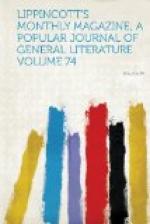The colors of the canopies are similar. On each
table are printed registers prepared for registering
the votes at each scrutiny, the schedules for giving
the votes, the means for sealing,
etc. On
the front of each table is inscribed the name of the
cardinal who is to occupy it, together with his armorial
bearings. In the midst of the body of the chapel
are six little tables covered with green cloth, with
a seat at each of them for the use of any cardinal
who may fear that his neighbor might overlook him
while writing his voting paper if he wrote it on the
table before his throne. In front of the altar
there is a large table covered with crimson silk,
on which are folded schedules, wafers, sealing-wax;
four candles, not lighted, but ready for use; a tinder-box
with steel and matches; scarlet and purple twine for
filing the voting schedules; a box of needles for
the same purpose; a tablet with seventy holes in it,
answering to the number of cardinals if the college
were full, and in each hole a little wooden counter
with the name of a cardinal, so that there are as
many counters as cardinals in the college; and finally,
a copy of the form of oath respecting the putting
the schedules into the urns, the two urns themselves,
and a box with a key, used for receiving the voting
papers of such cardinals as may be too ill to leave
their cells. The two urns, however, at the time
of the scrutiny are placed on the altar. Behind
the altar there is placed a little iron brazier or
stove, in which, after every scrutiny which does not
succeed in electing a pope, the voting papers are
burned, together with some damp straw, the object
being to cause a dense smoke, which, passing by a pipe
outside the building, serves to inform the Romans
that no election has yet been made. Twice a day,
at about the same hour every day till the election
is achieved, this smoke, which is eagerly watched
for by all Rome, and specially by the commandant of
the Castle of St. Angleo, who is waiting to fire a
salute for the new pope, tells the city that there
is no pope yet. When the hour passes and no smoke
is seen, it is known that the election is made, and
the cannoneers fire away without waiting to know whom
they are saluting.
There is no portion of the day or of the lives of
the cardinals in conclave which is not regulated by
a host of minute regulations and ceremonies.
The introduction of the food supplied to them; the
form of bringing it from their palaces; the method
of communication with the outside world, and the precautions
taken to prevent any communication with reference
to the great business in hand; the form and color of
the garments to be worn by their Eminences and by
all the subordinates; the amount of remuneration and
perquisites to be received by the latter (among which
regulations I find the following: “Let no
man receive anything who has not purchased the office
he holds"); the order of precedence of everybody,
from the dean of the Sacred College to the last sweeper
who enters the conclave with their Eminences,—all
subject to minute rules, which would require, one
would imagine, a lifetime to make one’s self
master of, and which, curious as some of them are,
it is impossible to find place for here. We must
get on to the method of voting.




